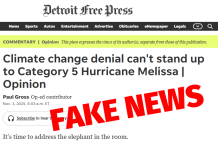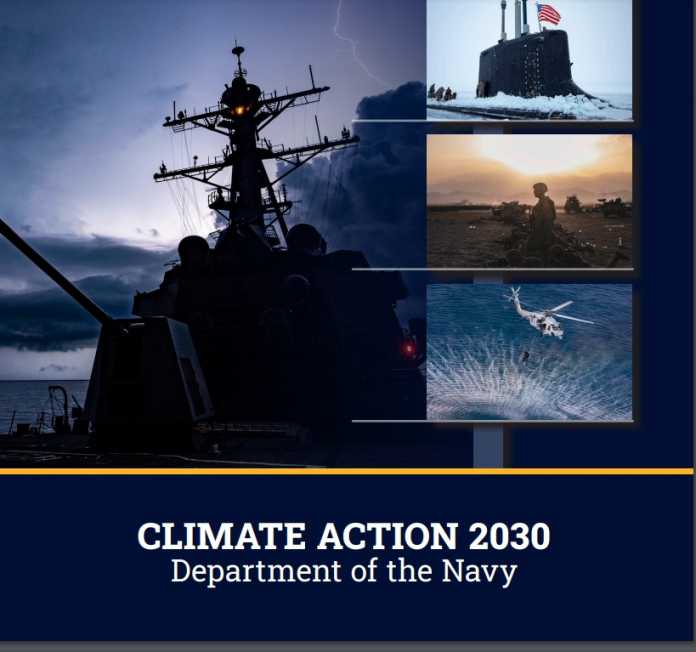Just when you think you heard it all, the Navy brass now more worried about “climate change” than they are about actual physical threats to the United States security. You have to wonder what compels people to think that a modest increase in average temperature rise over the past century is more worrisome than invasions by sea and air assaults from foreign threats such as China’s People’s Liberation Army Navy (PLAN). According to the Pentagon, China has the world’s largest Navy with 355 ships and counting.
The Pentagon reports, the PLAN is forecast to expand its inventory to 420 ships within the next four years. By 2030, the PLAN is expected to have 460 ships.
But somehow, getting electric amphibious assault vehicles for the U.S. Navy seems more important, than preparing to engage a geopolitical rival that almost daily instigates provocative actions against Taiwan, an ally the United States is committed to defending in the case of an invasion, because climate is supposedly the bigger threat.
FRANCIS P. SEMPA writes in The American Spectator:
Navy Secretary Carlos Del Toro just released “Climate Action 2030,” a 32-page report which identifies climate change as an “existential threat” to the U.S. Navy and the nation. In the report’s Foreword, Del Toro writes that climate is “the focal point” for his tenure as Navy Secretary, and notes that both President Biden and Defense Secretary Austin share that view. The Navy Department, Del Toro writes, will be an “environmental leader” that takes “bold climate action.”
…
The Navy Department report establishes two performance goals: to “build climate resilience” and “reduce climate threat.” Del Toro’s stated goal is to have the Navy Department “reduce its greenhouse gas emissions,” “stabilize ecosystems,” and “achieve … net-zero emissions by 2050.” Compare that to the goal of our nation’s most threatening naval adversary — China’s PLA Navy — which is to become the world’s leading naval power by 2049.
The Navy Department report is filled with color photographs of hurricanes, floods, electric vehicles, military families participating in an “oyster castle installation,” naval installations with solar panels, naval officers helping with disaster relief efforts, employees at a naval base planting salt marsh plants, electric-powered amphibious assault ships, and naval officers helping to install “mosquito surveillance and control equipment.” There are no photos of naval warfare, no references to [the primary mission], no discussion of the challenge posed by the PLA Navy.
This is arguably a prime example of an inverted threat appraisal psychosis, where small inconsequential things are deemed to be a bigger threat than actual physical threats. The American Psychological Association defines threat appraisal as; the cognitive and emotional processes involved in assessing the potentiality and level of threat.
The Navy brass is chasing phantom problems instead of what they are chartered to do.
In the U.S. Navy website, their mission is clearly stated in the About page:
“The Department of the Navy will recruit, train, equip, and organize to deliver combat ready Naval forces to win conflicts and wars while maintaining security and deterrence through sustained forward presence.”
There’s no mention of climate change, nor should there be. Also, as the unabated climate indicators such as atmospheric carbon dioxide have shown us so far, that after over 30 years of trying, it is an invisible, unwinnable, phantom war.

What they are missing is that climate change may actually benefit the United States rather than harm it.
An article by Dr. Matt Ridley, titled “Why global warming is good for us,” begins by noting “Climate change is creating a greener, safer planet,” and then proceeds to back up that claim with evidence.
The biggest benefit of emissions is global greening, the increase year after year of green vegetation on the land surface of the planet. Forests grow more thickly, grasslands more richly and scrub more rapidly. This has been measured using satellites and on-the-ground recording of plant-growth rates. It is happening in all habitats, from tundra to rainforest. In the four decades since 1982, as Bjorn Lomborg points out, NASA data show that global greening has added 618,000 square kilometres of extra green leaves each year, equivalent to three Great Britains.
We wrote about it in a review then:
Research published at Climate Realism confirms Ridley and Chan’s claims, having previously describe the benefits for vegetation in general, in numerous articles, here, here, here, and here, for example. Also, of course, as Ridley and Chan note later in their article, warming has also boosted global crop production tremendously. This latter point has been made in dozens of Climate Realism articles, for instance, here, here, here, and here.
Another benefit of modest warming detailed in the Spiked article is the decline in temperature and weather-related deaths during the period of modest global warming.
Another bit of good news is on deaths. We’re against them, right? A recent study shows that rising temperatures have resulted in half a million fewer deaths in Britain over the past two decades. That is because cold weather kills about “20 times as many people as hot weather,” according to the study, which analyses “over 74 million deaths in 384 locations across 13 countries.”
Once again, Climate Realism has been ahead of the curve in reporting on the decline in temperature and weather related deaths, for example, here, here, and here.
The Navy needs to “straighten-up and fly right” by paying attention to real threats facing America, foreign military powers, not phantom climate catastrophes.























June 25 2019 Must shrink this war machine: US military bigger polluter than 140 nations
In 2017, the US military bought about 269,230 barrels of oil a day and emitted more than 25,000 kilotonnes of carbon dioxide by burning those fuels. The US Air Force purchased $4.9 billion worth of fuel, and the navy $2.8 billion, followed by the army at $947m and the Marines at $36m.
https://wap.business-standard.com/article-amp/international/must-shrink-this-war-machine-us-military-bigger-polluter-than-140-nations-119062500436_1.html